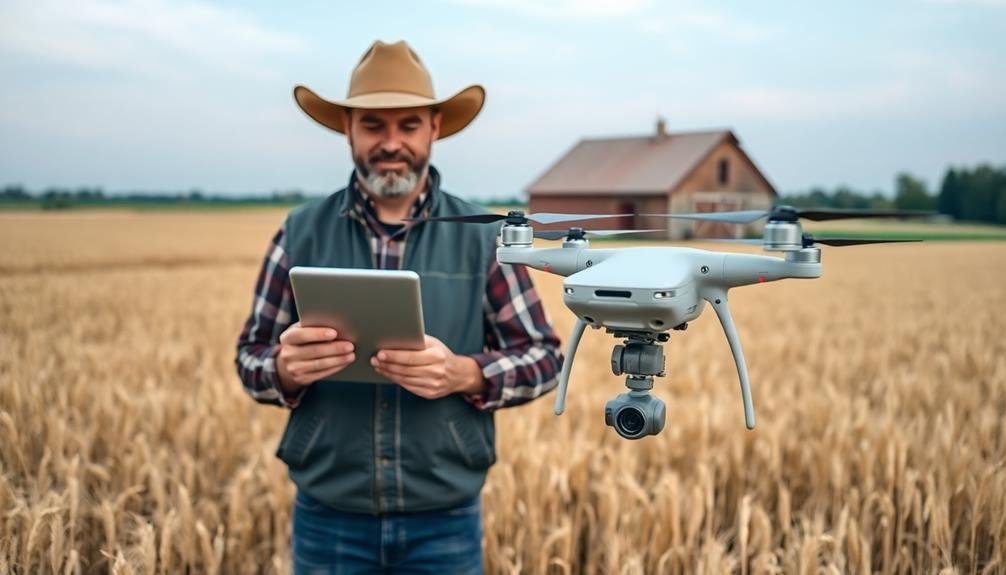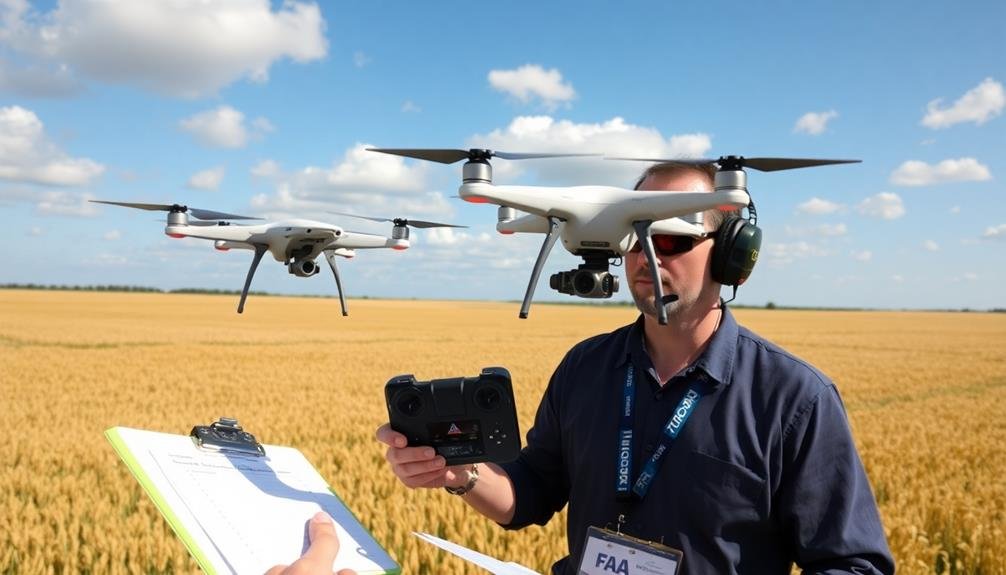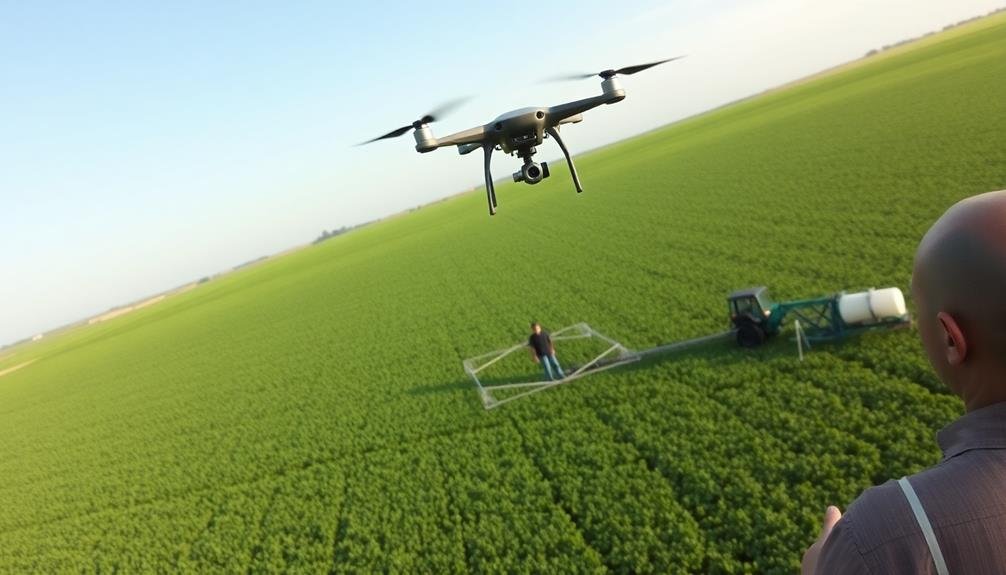To comply with farm UAV rules, you'll need to focus on three key areas. First, register your agricultural drone with the FAA if it weighs between 0.55 and 55 pounds. Second, obtain your Remote Pilot Certificate by passing the FAA's Aeronautical Knowledge Test and completing the necessary background checks. Third, always follow operational guidelines, including keeping your drone within visual line of sight, flying below 400 feet, and avoiding restricted airspace. By adhering to these rules, you'll guarantee safe and legal drone operations on your farm. Discover more about each step to enhance your agricultural drone compliance and efficiency.
Register Your Agricultural Drone

Before taking flight, you must register your agricultural drone with the Federal Aviation Administration (FAA). This applies to all unmanned aerial vehicles (UAVs) weighing between 0.55 and 55 pounds.
To register, visit the FAA's DroneZone website and create an account. You'll need to provide your name, address, and email. The registration fee is $5 and is valid for three years.
Once registered, you'll receive a unique identification number. Affix this number to the exterior of your drone in a visible location. Keep your registration certificate with you when operating the UAV.
If you're using multiple drones for farm operations, you can register them under a single number.
For drones weighing over 55 pounds, you'll need to follow a different registration process. These larger UAVs require registration through the FAA's paper-based system.
You'll complete Form AC 8050-1 and mail it to the FAA's Aircraft Registration Branch.
Obtain Necessary Pilot Certifications

After registering your drone, your next step is obtaining the necessary pilot certifications. For agricultural drone operations, you'll need to acquire a Remote Pilot Certificate from the Federal Aviation Administration (FAA). This certification guarantees you understand airspace regulations, weather patterns, and safe flying practices.
To obtain your Remote Pilot Certificate, you must pass the FAA's Aeronautical Knowledge Test. This exam covers topics such as regulations, operating requirements, and emergency procedures. You can prepare for the test by studying the FAA's Pilot's Handbook of Aeronautical Knowledge and the Small Unmanned Aircraft Systems study guide.
Once you've passed the test, you'll need to complete an FAA Airman Certificate application. This process includes a background check conducted by the Transportation Security Administration.
After approval, you'll receive your temporary certificate, followed by a permanent one in the mail.
Follow Operational Guidelines

Several operational guidelines must be followed when using drones for agricultural purposes.
First, you'll need to keep your drone within visual line of sight at all times during operation. This means you should be able to see it without the aid of binoculars or other devices. You're also required to fly below 400 feet above ground level and maintain a maximum speed of 100 mph.
Don't operate your drone over people not directly involved in its operation, and avoid flying near other aircraft. It's essential to respect privacy rights and not conduct surveillance of individuals or property without permission.
When flying near airports, you must adhere to specific airspace restrictions and may need to obtain authorization from air traffic control.
Weather conditions are important too. You shouldn't fly your drone in adverse weather like strong winds, rain, or low visibility. Always check for temporary flight restrictions in your area before each flight.
Frequently Asked Questions
Can I Use My Agricultural Drone for Non-Farming Purposes?
You can use your agricultural drone for non-farming purposes, but you'll need to follow different regulations. Check local laws and FAA guidelines for recreational or commercial use. Always prioritize safety and respect privacy when flying your drone.
How Often Do I Need to Renew My Drone Registration?
You'll need to renew your drone registration every three years. Don't forget to mark your renewal date on your calendar. It's a simple process that you can complete online through the FAA's DroneZone website.
Are There Restrictions on Using Drones Near Livestock?
Yes, there are restrictions on using drones near livestock. You'll need to keep a safe distance to avoid spooking animals. It's best to consult local regulations and obtain permission from property owners before flying near farms.
What Insurance Options Are Available for Agricultural Drone Operators?
You've got options for agricultural drone insurance. You'll find specific UAV policies, add-ons to existing farm insurance, and liability coverage. Don't forget to check for hull insurance and third-party damage protection. Always compare rates and coverage.
Can I Modify My Agricultural Drone for Improved Performance or Functionality?
You can modify your agricultural drone, but be cautious. Check manufacturer guidelines and warranty terms first. Consider upgrading sensors, batteries, or propellers. Don't alter critical components or software without expert help. Always prioritize safety and compliance.
In Summary
You've now learned the key steps to comply with farm UAV regulations. Remember to register your drone, get the right certifications, and stick to operational guidelines. By following these rules, you'll guarantee you're flying legally and safely. Don't forget to stay updated on any changes in regulations. With these best practices in mind, you're ready to make the most of drone technology in your agricultural operations.

As educators and advocates for responsible drone use, we’re committed to sharing our knowledge and expertise with aspiring aerial photographers.




Leave a Reply